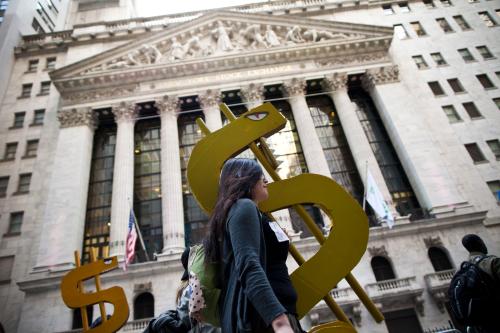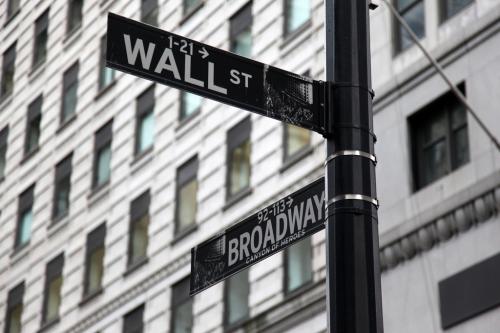What was the period in American history when the nation went the longest without a single bank failure? It was from 2004 to 2007. For 32 consecutive months in that period, not a single one of the over 7,000 banks in America failed. This ought to have set off alarm bells on the growing imbalances and problematic practices endemic in the American banking system. Instead, it was met with applause by the financial regulators charged with protecting the safety and soundness of a system that was veering toward collapse. As the Office of the Comptroller of the Currency (OCC), which regulates national banks, wrote in its 2006 Annual Report:
“This was the second consecutive year in which no national bank failed. Capital was strong and earnings increased, driven by strong growth in noninterest income. Healthy loan growth helped compensate for narrowing net interest margins. Losses and delinquencies were minimal. In short, the picture at year-end was quite positive.”
A decade after the financial collapse, we have yet to fully internalize that the goal of financial regulation ought to be a healthy marketplace in which individual banks experiment, compete, take risks, and—yes—ultimately fail.
To be clear, widespread bank failure is obviously not the goal. But the difference between rare bank failures and no bank failures is an important one. When not a single bank is failing over a long stretch of time, it is strong warning sign of major problems. No competitive, diverse marketplace should avoid failure of any institution. Banks are supposed to be in the business of judging and taking risk and competing with one another to give consumers the best deal. In that environment, some must fail. If none are failing, then everyone is misjudging risk. Financial regulators need to realize that possibility and not draw the mistaken conclusion that the banking industry is in such good shape that capital and risk management should be relaxed. A step in the right direction would be for financial regulators to publicly state that the optimal number of bank failures in any given year is greater than zero. In fact, never between 1933 when the Federal Deposit Insurance Commission (FDIC) was created and the run up to the financial crisis in 2004, did a full calendar year go by without a single bank failing. Only six times over the past 85 years did any twelve consecutive months go by without a failure. The stretch leading up the crisis was more than twice as long as any other stretch since just after the end of WWII. The chart below captures those times, most of which were in the 1950s and 1960s when banks couldn’t effectively operate in multiple states because federal law forbade it. It also highlights how unusual the period in the run-up to the crisis was, when banks appear almost unable to fail.
| Longest periods of zero bank failures since 1933 | |
|---|---|
| June 2004 – February 2007 | 32 months |
| January 1945 – September 1946 | 20 months |
| August 1996 – November 1997 | 15 months |
| February 1953 – May 1954 | 15 months |
| February 1962 – May 1963 | 15 months |
| October 1955 – October 1956 | 12 months |
To be clear, banks rarely fail. While every year between 1943 and 1974 had at least one failure, none had more than 10. The lack of widespread failure is due in part to bank regulators who are charged with protecting the safety and soundness of the banks they regulate. There is good reason for bank regulators to have this goal: taxpayers are ultimately on the hook for the deposit insurance they provide to protect bank depositors. It is also because the business of banking is inherently profitable. Banks are given charters by the government — as opposed to licenses like almost every other business – to provide maturity transformation the critical process of bridging short term savings into longer term investments. This unique and protected service should generate profits in a developed and growing economy and be able to weather most economic storms. Ultimately banks succeeding or failing is based on their core business model of judging risk, making loans and providing valuable services to their customers. But systemic misjudgment of risk is a serious problem and a threat to financial stability. When the market is underestimating risk, as was the case from 2004 through 2007 when many banks were making and/or investing in horribly risky mortgages, then a financial bubble is likely—and the bursting of that bubble will cause great damage. In the five years after this period of zero bank failure, almost 500 banks failed at a cost of approximately $73 billion to the federally provided Deposit Insurance Fund (DIF). When the market is overestimating risk, then banks are not lending enough and consumers and businesses suffer. The financial regulators job is to know which one of these is the case and to lean against the prevailing wind. Our recent experience with the problems that led to the great financial crisis of a decade ago — and caused the corresponding great ‘no bank failure’ period right before it — have understandably lead to great deal of attention being paid to trying to identify and avoid periods of under estimating risk. This focus is frequently captured in the term ‘financial stability’, which has become an area of great interest among financial regulators and policymakers.
Seeking financial stability is not and should not be about preventing failure.
Seeking financial stability is not and should not be about preventing failure. To the contrary, a stable financial system is one in which banks fail. It is just that the failure of one or many banks does not threaten the entire financial system’s ability to function. As the Federal Reserve’s definition of ‘financial stability’ correctly points out: “Financial stability is about building a financial system that can function in good times and bad, and can absorb all the good and bad things that happen in the U.S. economy at any moment; it isn’t about preventing failure or stopping people or businesses from making or losing money. It is just helping to create conditions where the system keeps working effectively even with such events.” Correctly defining the goal is an important first step. The real test comes when regulators are operationalizing this definition and therefore ensuring that banks are able to take risks and allowed to fail. This was a test that regulators and policymakers failed during the run up to the crisis. In real time, financial regulators were drawing the opposite conclusions and praising the industry and themselves for the fact that no bank had failed on their watch. Concerns regarding subprime mortgages and risky mortgage backed securities were dismissed by pointing to strong bank earnings and supposedly well-capitalized financial institutions that were successfully off-loading financial risk. Instead of assuming success for a lack of failure, bank regulators should draw the opposite conclusion: get nervous when no banks fail. When it appears impossible for a bank to fail, financial regulators should start asking tougher questions and raising larger concerns about the proper state of financial regulation. Any bank regulator should be concerned when not a single entity has failed on their watch, and members of Congress should increase their oversight of regulators when that is the case. It is a signal that financial stability, as properly defined, is not being achieved. I and everyone else who was involved in responding to the financial crisis never want to see another month with the wave of bank failures that happened in September 2008. However, if no bank fails through the end September, it will have been 9 months since the last bank failed. This is not a sign of a financial crisis brewing, but it is also not a sign of success.






Commentary
When no banks are failing, you’ve got a silent canary in a coal mine
September 11, 2018